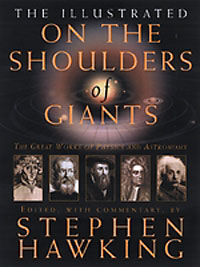Stephen Hawking on the men who shaped the known universeby Taylor Dinerman
|
| What all these men have in common is that they successfully challenged the dominant view of their day of the way the world around them was structured. |
Copernicus studied law and medicine at the great center of Renaissance learning, the University of Bologna. After he observed a lunar eclipse in Rome, in 1500, he dedicated himself to astronomy, as well. Hawking uses Thomas Kuhn’s term “paradigm shift,” to describe the effects of the Copernican heliocentric theory,“…opening the way to modern astronomy and broadly affecting science, philosophy and religion.”
It is sometimes said, that science has demoted humankind from its place at the center of the universe in medieval Christian cosmology, to something resembling a random collection of complex molecules. This was certainly not the intention of Copernicus, and probably not that of any of the other scientists. They were chasing knowledge and truth. In the process, they would inevitably upset long established ideas. Some, like Galileo and, to a lesser extent, Kepler, would suffer for it. In one extreme case, Giordano Bruno would be burned at the stake for being too open with his (fairly accurate) ideas about the nature of the universe.
Yet, in spite of these obstacles, the hunt for knowledge and truth continued, and continues, to this day. This says something about our civilization. It is the West’s willingness to destabilize the very basis of its own worldview. Its habit of constantly holding itself, and its beliefs, up to critical examination, seems an important factor in its success.
Copernicus wrote: “This more divine than human science, which inquires into the highest things, is not lacking in difficulties.” Was it this willingness to attempt to balance religious faith with observable fact, leading inexorably to a new theory incorporating these facts, that made the European Early Modern period so unique? The religious establishment of the period was almost as dogmatic and intolerant as any in the history of the world, but, in spite of this, science was able to push forwards.
For almost two hundred years, the Reformation and the Wars of Religion tore apart one nation after another. In 1633, in the middle of the horrors of the Thirty Years War, a year of famine and plague in Bavaria, Italy was an insecure rear area in which Hapsburg armies were armed and equipped before being sent into the firestorm north of the Alps. In the same year, Galileo Galilei was put on trial in Rome on charges of heresy “…for supporting and teaching the idea that the Earth moves and is not the center of the universe… they sentenced him to life imprisonment.”
| Western civilization develops itself on the basis of a few nagging doubts, messy compromises, and the occasional individual of courage and genius, willing to challenge the established wisdom of the moment. |
In exchange for sparing his life, Galileo was ordered to publicly renounce his beliefs, on his knees. Hawking includes a full translation of the text of abjuration. This included the elegant and lawyerlike sentence, “I did write and cause to be printed a book in which I treat of the said already condemned doctrine, and bring forth arguments of much efficiency in its favor, without arriving at any solution.” No wonder the legend arose that, after making this statement, he muttered under his breath, “Eppur si muove” (and yet, it still moves.) The Church had the power to condemn him, but it lacked the self-confidence to execute him and, because of this, left the door open to the possibility that he might be right.
So, Western civilization develops itself on the basis of a few nagging doubts, messy compromises, and the occasional individual of courage and genius, willing to challenge the established wisdom of the moment. Hawking’s tribute to five of these geniuses is a worthy one. This edition is beautifully illustrated, particularly with a selection of computer generated images by Moonrunner Design. There are also a few striking photographs from the space program of the Earth rising over the surface of the Moon and of an empty space shuttle external tank falling into the upper atmosphere.
In this season, it would make a great gift for any aspiring scientist or engineer or for anyone interested in the history of science.
